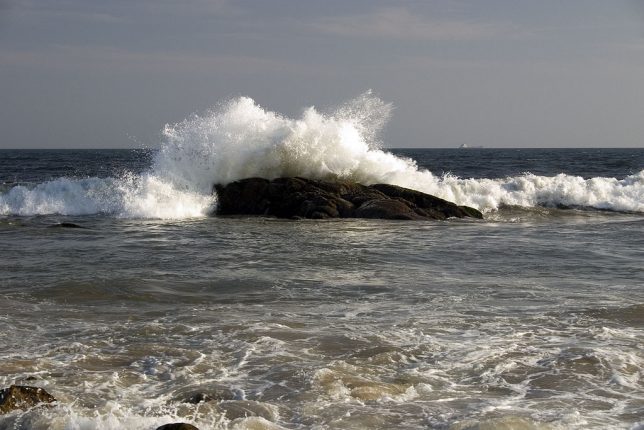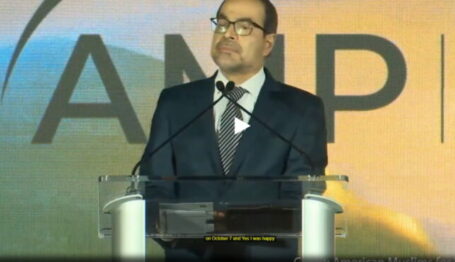Foundation Watch
The Tides Foundation and Center: Selling Foundation Philanthropy on the Idea of “Structural Racism”
 Image credit: Wiki Commons
Image credit: Wiki Commons

(PDF version here)
Summary: The Tides Foundation is a public charity designed to allow anonymous pass-through funding by donors, and the Tides Center acts as an incubator for radical advocacy nonprofits. But the whole is greater than the sum of Tides’ parts. The innovative structure of the Tides network is designed to secure funding for and nurture the growth of radical nonprofits along a wide range of issues. But the most important— and dangerous—Tides initiative is its effort to promote the concept of “structural racism.”
For over 30 years the Tides Foundation and Tides Center of San Francisco have nurtured a little-known but influential network of left-wing philanthropists and activists. Tides’ work has slowly achieved notoriety thanks to efforts by Capital Research Center, radio and TV commentator Glenn Beck, and other conservatives who have diligently catalogued its activities. For one thing, Tides’ giving is titanic. As a 2010 issue of CRC’s Foundation Watch noted,1 Tides’ grantmaking is in the same league as George Soros’s Open Society Institute. From 1999 through 2008, Tides distributed $630.6 million in grants, a sum within hailing distance of the Open Society Institute’s $901.4 million, according to FoundationSearch. com records.
But Tides is far more than a grantmaker. Its original entity, the Tides Foundation, was founded by Drummond Pike, the son of a San Francisco-area investment banker. Pike began his career on the professional left as an anti-war protester and campus activist before moving into the world of philanthropy. In 1976 he established the Tides Foundation to work with “community-based nonprofit organizations and the progressive movement through innovative grantmaking.” Pike’s use of the concept of the donor-advised fund is supposed to have originated when a New Mexico couple asked him to help them make anonymous grants to several environmental groups.
But Pike soon came to understand that radical activists need more than just money to support themselves as they initiate programs and projects. They also need “back office” assistance: detailed technical advice on how set up an office, solicit money from donors, gain IRS recognition for one’s organization as a tax-exempt nonprofit, observe the legal lines separating 501(c)(3) “education and research” charities (contributions to which are tax-deductible) from 501(c)(4) lobby groups (contributions to which are not), and so forth. To meet these needs, Pike established the Tides Center in 1979 to incubate new political advocacy groups and provide them with the necessary organizational help.
In 1996 the Tides Center became legally separate from the Foundation, probably to ensure that anyone who sued one of Tides’ politically active offspring would find a firewall separating a disruptive activist group from the Foundation and its outside donors. But Pike remained the head of both organizations until he finally stepped down in late 2010, and the two groups still share directors and office space.
Critics of Tides complain that it is set up to “launder” money: tax laws enable an investigator to discover that a controversial activist group affiliated with the Tides Center gets money from the Tides Foundation. But those same tax laws make it impossible to discover the anonymous donors to the Tides Foundation. We’ll never know exactly who funds what.2
Critics also score the Tides Center for the dubious practice of “lending” its 501(c)(3) tax-exempt status to advocacy start-ups. Some fledgling Tides “projects” grow up and achieve independence. They eventually are incorporated as nonprofit organizations with their own board, sources of funding, and activities. For example, People for the American Way, the group that pioneered the kind of attacks on Republican judicial nominees known as “borking,” started out as a Tides project. It now consists of two separate organizations, the 501(c)(3) People for the American Way Foundation (2009 revenue: $5.2 million) and the 501(c)(4) People for the American Way Action Fund (2009 revenue: $2.9 million). But Tides could also create other “projects” that are purposely shortlived— created near election time with no hope of sustaining themselves or gaining IRS tax exemption, they could disappear quickly leaving no trace of their activities.
Tides is well-known for supporting environmental activist groups, including the Ruckus Society, whose members were caught up in violent protests at the 2000 Republican National Convention and riots in Seattle against the 2001 meeting of the World Trade Organization. Ruckus has multiple ties to Tides and its offshoots, and its funding from Tides includes almost $150,000 in grants from 2005-2010.2
In 2010 Tides made grants totaling $97 million, a decline from $105 million the previous year. It has supported groups engaged in anti-war protest, opposition to free trade, bans on firearms ownership, abolition of the death penalty, and advocacy for abortion rights and gay rights.4 It also makes grants overseas. About 1,000 of its 2010 grants went abroad to organizations in Burkina Faso, Bangladesh, Rwanda, France, Benin, Canada, Ireland, Germany, Hong Kong, Great Britain, the Philippines, Guyana, Venezuela, Nicaragua, Lebanon, Mexico, China, and many other lands.
Tides is also well-connected to ACORN, the network of community organizing groups whose run-ins with the law are responsible for its demise and rebirth under many new names. Wade Rathke, ACORN’s founder and “chief organizer,” was an original and longtime board member of the Tides Foundation. The most publicly embarrassing ACORN scandal involved Rathke’s covering up a nearly $1 million embezzlement committed by his brother Dale, ACORN’s chief financial officer, which led to his ouster at ACORN and Tides. The scandal intensified with the additional revelation that Pike personally contributed some $700,000 to cover the Rathke family’s ACORN “debt.”5
“Structural Racism”: A Concept to Remake America
In recent years environmentalism has seemed to enjoy pre-eminence as a “progressive” social movement. It has everything: wealthy donors, a powerful network of well-funded and professionally staffed national organizations, and legions of young and committed followers. Environmentalism even functions as a quasi-religion with all the doctrinal trimmings: a fall of man, a catalogue of sins, a call to repentance and an ascetic way of life for the devout, dire warnings of a secular apocalypse when the seas rise and the earth grows hot, and a promise of salvation. With carbon offsets (plant a tree, drive a Prius), it even has the equivalent of religious indulgences.
On the other hand, if you are a radical ideologue straining to revolutionize America, then improving the environment is not as potent a rallying cry as destroying the scourge of racism. First of all, environmentalism is something of a luxury good. When people are flush with wealth, they can assuage their guilt about their wasteful ways by donating to a green group or by taking a tax deduction for buying new energy-efficient windows or adding solar panels to the roof. But people don’t care much about global warming and endangered species if they are worried about losing their job or house.
Racism, by comparison, is a far more apparent evil. America has a tragic history of slavery and racial segregation; so the argument that economic misfortune is necessarily linked to one’s race is easy to make, especially with high rates of unemployment and home foreclosures in minority neighborhoods.
While few people are persuaded that it’s shameful to drive an SUV that produces excess carbon emissions, the charge of racism carries more weight. And now the charge is easier to make, thanks to the novel theory of “structural racism,” which allows radicals to claim that everyone is a racist, no matter how well–meaning their intentions and unbiased their actions. According to the theory, as long as there are statistical “disparities” among racial groups in the allocation of resources, all of America is “structurally racist.”
Of course, if America were so deeply racist, then donors would be obliged to combat this scourge. And if donors didn’t move fast enough, then perhaps laws would be required to make sure that foundations distribute a fixed proportion of their grants to groups established to combat structural racism. And perhaps the boards and staff of private foundations and their grantees should be evaluated to determine whether they are “inclusive” and have sufficient “diversity.” Indeed, in 2008 10 large foundations in California accepted a call to scrutinize themselves for evidence of racism when a race-baiting group called the Greenlining Institute almost persuaded the state legislature to mandate public disclosure of race, gender, and sexual orientation in the composition of foundation boards and staffs and grants recipients, a possible first step toward affirmative action quotas. (See John Gizzi, “California’s Greenlining Institute,” Organization Trends, August 2008.)
How Tides Promotes the View that America is Structurally Racist
The Tides network has long championed the theory of structural racism. Consider how it responded to a brave opinion article in the Chronicle of Philanthropy written by William Schambra, director of the Hudson Institute’s Bradley Center for Philanthropy and Civic Renewal. The article, “Philanthropy’s Jeremiah Wright Problem,”6 set off an explosion in the nonprofit world, drawing howls of protest from Tides projects, grantees, and fellow-travelers. Tides president Drummond Pike joined the public denunciations. Pike slammed Schambra as “deliberately misleading” 7 and “a fear-mongering conservative,”8 while Tides projects and grantees filled the Chronicle’s letters to the editor page with long and angry attacks.
What outrage did Schambra commit? He noted that the Rev. Jeremiah Wright had made “incendiary” claims that America was so racist that God should “damn America for treating our citizens as less than human.” Wright’s assertions were so offensive that Barack Obama cut his ties to his longtime pastor, and yet, Schambra observed, many large grantmakers appear to agree with Wright, because they fund radical nonprofits that “sustain a similarly harsh view of a nation riven by an unrelenting and deeply oppressive racial divide.”
Schambra carefully quoted report after report from group after group making the “structural racism” claim—and nearly all the groups were connected to Tides. For example, the Center for Social Inclusion, a project of the Tides Center,9 has attacked white people who support equal opportunity for all, declaring in a 2005 report that “Many whites are blind to structural unfairness precisely because of their structural advantages”; “their frame of colorblind ‘equal opportunity’ allows [them] to see themselves as supporting racial equality, and even as part of the solution, while actually maintaining racial hierarchy and legitimating white privilege.”
Schambra also quoted a publication of the Applied Research Center,10 which received $1.19 million in Tides funding in 2005-2010. The Center asserted that racism is manifest when funders merely make grants to “communities of color for services and programs” or focus on “interpersonal aspects of race and racism.” That’s woefully inadequate, the Center observed. Donors should be sternly criticized if they aren’t also “exposing systemic inequities, confronting institutional practices, and initiating policy reform.”
Schambra cited a Tides Center project called the Philanthropic Initiative for Racial Equity. It had declared structural racism a grave problem. Although efforts to increase “diversity and inclusiveness are important commitments,” they are “ultimately not powerful enough to drive the changes” that foundations should strive for. The project’s declaration appeared in a Ford Foundation guidebook for donors.
For the Western States Center (recipient of $425,000 from Tides during 2005-2010), it was not enough to be a political advocate fighting against racism. You had to do it the right way. The Center cautioned that it is “not enough to work for reforms and policy initiatives that may positively impact people of color…if we are not explicit about racism as a root cause of the problem.”
What must donors do to convince their grantees that they are not riddled with racism? Engage in self-loathing, apparently, or at least loathing of America. For evidence, Schambra cited Eric Mann of the Poverty and Race Research Action Council, which was co-founded by a Tides board member who is a leader of the Structural Racism Caucus. Mann praised the notorious 2001 U.N. World Conference Against Racism held in Durban, South Africa, because the conference demonstrated that “in any arena in which the struggle against racism and colonial domination is taken seriously, the U.S. empire…self-nominates as the main cause of organized racism and national oppression in the world.”
Mann looked forward to a movement for reparations that “will be driven by years or even decades of a ‘crimes against humanity’ tribunal, with European and U.S. imperialist civilization on trial.” The tribunal’s findings would “challenge the very legitimacy of the U.S. to exist as a nation state, and call into question its settler-state history of genocide against both indigenous peoples and blacks.”11
The U.S. delegation walked out of the Durban conference to protest such talk. But Linda Burnham of the Tides-funded Women of Color Resource Center lauded its speakers and criticized the departing U.S. delegation. Schambra quoted Burnham speaking at an awards ceremony a month after September 11, 2001, when she explained that “our time in Durban did give us hope, despite the actions of the U.S. government and others who refused to honestly engage the struggle against racism.”
During the same speech Burnham described her attitude toward the 9/11 attacks: “The dream of endless greed, aggression and world dominance has been revealed for the appalling nightmare it always was. The fortress has been breeched. And it will be breeched again and again as long as we have a hand in feeding the desperation, alienation and disillusionment that stoke the myriad forms of murderous male rage.”12 (The awards ceremony honored Rep. Barbara Lee, D-Calif., for being the only member of Congress to vote against a 2001 resolution authorizing the use of force in Afghanistan.)
Schambra concluded his survey by wondering whether these views didn’t deserve to be repudiated just as Senator Obama had repudiated the views of the Rev. Wright, whose sermons, Obama warned, express “views that have the potential not only to widen the racial divide,” but also to “denigrate both the greatness and the goodness of our nation.”
Tides and its offspring howled with outrage at this equation, and they filled the Chronicle of Philanthropy with long letters insisting that Schambra was “inaccurate” and “inflammatory.” The concept of “structural racism” was certainly not “a radical leftist agenda,” protested the National Committee for Responsive Philanthropy, a recipient of several small Tides grants.13 Two articlelength letters were sent by the “Structural Racism Caucus,” nearly every one of whose organizational members had been quoted by Schambra and received support from Tides. None disputed their own quotations. Yet the groups assured readers that acknowledging “the problem of structural racism” in no way “malign[s] fundamental American values, virtues, or accomplishments.”14
The Ford Foundation (which in 2010 alone gave $5.2 million to Tides) contrasted Schambra, a source of “hyperbole and dark innuendo,” to the “courageous Americans” who are “fighting against discrimination, narrow-mindedness, and fear of difference.” The nonprofits Schambra cited, said the Ford spokesman, are “as diverse as our nation is—and as rich in optimism, purpose, and patriotism.”15
William L. Taylor, a board member of the Poverty and Race Research Action Council, accused Schambra of “invective and bigotry” and McCarthyite rhetoric. Taylor insisted that the “respected foundations” and organizations Schambra cited “have established track records of working for equality of opportunity.” 16 But that claim contradicts the theory Taylor was defending. “Structural racism” rejects calls for “equal opportunity” on the grounds that a “colorblind strategy ensures that racial disparities will continue.” That’s how one of the Structural Racism Caucus’s letters to the Chronicle put it. The Caucus added that “Today’s institutions no longer need to intend discrimination in order to create inequality.” Having the best of intentions and providing equal opportunity on a colorblind basis is worthless, according to the theory of structural racism.
Tides founder Drummond Pike not only sent his own letter 17 but published two additional blog posts.18 In these writings, Pike made it clear that the Chronicle of Philanthropy had no business publishing Schambra’s article.
Don’t Scare the Donors
Why would Pike fear an article that simply quoted his grantees’ deepest convictions? Perhaps the answer lies in the fear that potential donors might be scared away were they to understand the true meaning of “structural racism.” Pike had begun his philanthropic career at the Youth Project, a Washington, D.C. group that attempted to guide young heirs into “social change philanthropy.” Remember that although Tides has substantial assets to make its own grants, its mission is to cultivate donors who will support its radical nonprofit clients and friends. A key Tides project, the Philanthropic Initiative for Racial Equity (PRE), delicately describes the way it cultivates donors for the “anti-racist” agenda: “PRE understands the importance of meeting people where they are on their own continua of learning and comfort level in addressing what can often be difficult and controversial issues.”19
In other words, not every liberal donor is ready to believe America is a genocidal country lacking the legitimacy to exist as a nation-state. PRE gently assists these weak-willed grantmakers, helping them to understand “the strengths and weaknesses of different racial equity efforts,” and “engaging in internal assessments of foundations’ institutional needs around racial equity and diversity, and coordinating or adapting tools to most effectively meet them.”
PRE’s structural racism agenda is powerfully connected to the grantmaking world of foundation philanthropy. PRE works with GrantCraft, a project of the Foundation Center and the European Foundation Centre; with regional associations of grantmakers, including Washington Grantmakers, New York Regional Association of Grantmakers, Philanthropy Northwest, Northern California Grantmakers, and Associated Grant Makers; and with affinity groups like the Environmental Grantmakers Association, Grantmakers for Education, and Grantmakers for Children, Youth and Families, as well as Funders Network for Smart Growth and Funders for Lesbian and Gay Issues. It also works with the Tides offspring in the Structural Racism Caucus, and with donor groups it has “spun off,” including Women Donors Network, and Grantmakers for Effective Organizations.
The Long Arm of the Law
Proponents of structural racism are willing to resort to legal compulsion when gentle persuasion fails. As previously mentioned, the Greenlining Institute attempted to pass a bill in California called AB 624. Introduced in 2005 by state assemblyman Joe Coto, a powerful committee chairman, the bill would have forced “every private, corporate, and public operating foundation” with assets greater than $250 million to disclose the “race, gender, and sexual orientation” of its board of directors and staff; the percentage of contracts given to businesses owned “by specified groups”; and the number of grants and percentage of grant dollars going to groups “where the grantee’s board of directors and/or staff” belong to “specified groups.”
Ironically, the “specified groups” weren’t specified in the original bill, but favored groups organized along the lines of “race, gender, and sexual orientation” were clearly what was intended. The bill passed the lower house of California’s state legislature, and Governor Arnold Schwarzenegger initially refused to take a position on it. Although it aroused powerful opposition from groups like the Philanthropy Roundtable, the Alliance for Charitable Reform, and even the left-of-center Council on Foundations, this affirmative-action scheme for private charity dollars was only derailed when 10 foundations, including some of California’s wealthiest, cut a backroom deal to pay off groups like the Greenlining Institute that were demanding the law. Since then, efforts to pass similar laws in other jurisdictions— including Florida, Pennsylvania, Texas, New York, and the U.S. Congress—have ebbed and flowed.
(Florida eventually enacted a law prohibiting the collection of such information from grantmakers. According to National Review’s John J. Miller,20 a paper written for the James Madison Institute 21 by Capital Research Center senior editor Matthew Vadum was crucial in the legislation’s passage last year.)
Opponents of the California bill fear that its “reporting requirements” are just the first step in an effort to shake down private foundations the way hucksters like Jesse Jackson and Al Sharpton extract support from corporations. The fear is well justified, as revealed by commentary on the bill at the website of Tides’ Philanthropic Initiative for Racial Equity. Contributor Rick Cohen is explicit: “To restructure foundations for the representational equity they need, there has to be a clear plan and timetable for diversifying foundation boards, family foundation boards and others” (emphasis in the original).22
After family foundations are forced to quota-hire for their boards, Cohen thinks they should give local versions of Al Sharpton access to their assets: “In discussions that will legitimately influence access to foundation resources, the foundation community must structurally incorporate community leaders into decision-making roles within grantmaking institutions. It’s time to democratize how foundations make decisions about community grantmaking” (emphasis in the original).
In a separate article for PRE, Cohen makes another thing clear: The proposed law in California didn’t go far enough because it didn’t set stringent left-wing ideological standards for grantees. Cohen raises what is for him a nightmare possibility, namely, that grants “to organizations entirely opposed to the racial/ethnic priorities of the Greenlining Institute” would count as proper grants to minorities. He’s especially appalled that the law couldn’t object to funding “African American anti-affirmative action activist Ward Connerly’s California-based American Civil Rights Institute (whose slogan is ‘race has no place in American life or law’).”23
For now at least, the Tides family cannot use the law to compel foundations to organize their philanthropy by race or send money to ideologues chosen by structural racism experts. Until that day comes, Tides will likely do better to channel its philanthropy to favored groups, continue to expand its influence in the grantmaking world, and foster its own internal philanthropy “projects,” which include
– African Grantmakers’ Affinity Group – Center for Global Collaboration and Health Initiatives – DiversityRx – Funders Workgroup for Sustainable Production and Consumption – Groundswell Fund – Independent Council for Safe Energy – Lambent Foundation – National Network of Consultants to Grantmakers – Philanthropic Initiative for Racial Equity – Safety Net Partnerships
It’s easy to imagine Tides distributing enough money from anonymous donors and its own coffers to someday achieve its goal of reshaping America. It’s just not pleasant.
1. “The Tides Foundation and Center: Brokers of the Revolution,” Foundation Watch October 2010, at http://www.capitalresearch.org/pubs/pdf/v1285956045.pdf.
2. See the critique by ActivistCash.com, at http://activistcash.com/organization_overview.cfm/o/225-tidesfoundation–tides-center.
3. See grant lists at http://www.tides.org/impact/grantees/.
4. “The Tides Foundation: Liberal Crossroads of Money and Ideas,” Foundation Watch December 2003, at http://www.capitalresearch.org/pubs/pdf/x3797262231.pdf.
5. Stephanie Strom, “Head of Foundation Bailed Out Nonprofi t Group After Its Funds Were Embezzled,” New York Times (August 16, 2008), at http://www.nytimes.com/2008/08/17/us/17acorn.html.
6. Chronicle of Philanthropy (June 26, 2008); http://pcr.hudson.org/index.cfm?fuseaction=publication_details&id=5652
7. http://pcr.hudson.org/index.cfm?fuseaction=publication_details&id=5652#_PikeLetter.
8. http://drummondpike.tides.org/index.php/2008/06/12/chronicle-on-philanthropydid-fox-news-just-buy-you/.
9. http://www.tides.org/community/project-directory/show/project/single/title/center-for-social-inclusion/
10. http://www.arc.org/.
11. http://onlinelibrary.wiley.com/doi/10.1111/1467-8330.00260/abstract.
12. http://coloredgirls.live.radicaldesigns.org/article.php?id=89.
13. http://pcr.hudson.org/index.cfm?fuseaction=publication_details&id=5652#_NCRPLetter.
14. http://pcr.hudson.org/index.cfm?fuseaction=publication_details&id=5652#_CaucusLetter. The Structural Racism’s second letter to the editor is available at http://pcr.hudson.org/index.cfm?fuseaction=publication_details&id=5652#_CaucusLetter2.
15. http://pcr.hudson.org/index.cfm?fuseaction=publication_details&id=5652#_TelladoLetter.
16. http://pcr.hudson.org/index.cfm?fuseaction=publication_details&id=5652#_TaylorLetter.
17. http://pcr.hudson.org/index.cfm?fuseaction=publication_details&id=5652#_PikeLetter.
18. http://drummondpike.tides.org/index.php/2008/06/12/chronicle-on-philanthropydid-fox-news-just-buy-you/ and http://drummondpike.tides.org/index.php/2008/06/26/118/#more-118.
19. http://www.racialequity.org/projects.html.
20. http://www.heymiller.com/2010/06/give-freely/
21. http://www.jamesmadison.org/wp-content/uploads/pdf/materials/2009-12-policy.pdf
22. http://racialequityblog.wordpress.com/2009/06/22/putting-the-ab-624-agreement-into-practice-and-policy/.
23. http://www.racialequity.org/docs/Cohen.pdf



